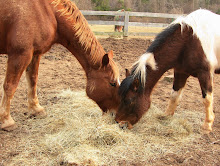I'm in Carolyn's current Insider Circle Program and am LOVING every minute of it. I am going to save up so I can go to her ranch in CA and meet her!
Freedom to Resist Leading From Behind-Carolyn Resnick
The practice of Leading From Behind™ brings the horse a sense of belonging. With practice, it will help your horse to listen to his bonding instincts. A horse that gets to practice his instincts receives well being and enthusiasm for life and builds a healthy ego. From the practice of Leading From Behind we are returning a horse to his roots, and his understanding of life as a herd animal, like letting a bird out of a cage to fly. When a horse accepts Leading From Behind, it causes a horse to trust you more because Leading From Behind is a herd behavior.
The practice of Leading From Behind builds the character of the horse, giving the horse a greater work ethic for all forms of training. Along with the work ethic, the horse develops an optimistic attitude. When we can develop a horse to enjoy learning before he starts classical training a horse needs a lot less guidance because the horse’s focus is on learning and wanting to connect and fit with his trainer.
Leadership Accepted Naturally
When you are practicing Leading From Behind it causes a horse to accept your leadership in a natural way. Lead stallions use it for rounding up the herd and moving the herd to new locations for safety and greener pastures. Mares use it when the herd is not on the move to keep the herd focused and respectful of her presence. All horses use it when the herd is on the move. I believe this is how pecking order got started. All horses know how to Lead From Behind and the ones that are best at it are higer in rank. Leading From Behind can remove the need for confrontation in pecking order squabbles.
When the horse give up his resistance to being Led From Behind, the horse develops a desire to be responsible and wants to follow your lead. The practice of this Ritual takes the aggressive behavior out of a horse; as well as causing a shy horse to feel more secure from the structure it offers the horse.
Trust, Trust, Trust
For the people in the Insider Circle and Extended Circle programs, you are going to be stepping into Leading From Behind shortly from the Five Piles of Hay Exercise™. I will explain in more detail in the classroom of the affects and approaches. In the beginning, you may feel confused, or frustrated, or concerned for a short while on this Ritual- and so will your horse probably. But because you are working at liberty and on a Ritual that is natural to horses, this will be short lived. The reason I am mentioning it is to not let that confusion stop your practice.
Don’t worry about loosing the bond. It is normal. When you are working with a horse at liberty you cannot destroy what you have even if the horse initially doesn’t like being Led from Behind. One of the ways a horse with show his resistance in Leading From Behind is by running away from you, which will only improve the horse’s gas pedal for those of you who have a horse a little on the slow side. Your job is to go through the process and not judge what is going on in the moment. Keep your energy low, and keep walking after your horse. When you will get up to your horse, hang out with him there for a while until the connection is felt and all resistance has left. When you feel the connection is back, you begin again.
After a couple of weeks of practice, everything should be working smoothly and all resistance relieved. It will be truly worth it in what you learn, and how it deepens your connection and trust with your horse. I want to reassure everyone that the running away will deepen the trust and the bond when freedom is given and no consequence is received.
Surfacing Resistance
You are going to bring up the resistance that is laying dormant in the horse and that is a good thing, because we need to get it released. By letting him express the resistance without repromand causes the horse to let go of it. It takes time for a horse to release resistance, and little by little the horse releases all his resistance on his own accord.
The equestrian world is oriented toward having a workable plan to fix the problem of resistance in a horse by using an approach that tries to stop the behavior from occurring, rather than letting the behavior run its course without confrontation. Generally equestrians have a hard time giving a horse a right to control them through resisting what is asked. But the resistance without control or confrontation has a strong bonding component that leads to a great work ethic that takes place from the practice of Leading from Behind.
A horse with tack appears ok when we ask him to do something that is very simple, but in reality, there is hidden resistance and this is what we need to get to the bottom of. At liberty, a horse expresses the truth in how he feels about a simple request. This is very valuable to flush out a horse’s attitude and to make peace with it through a process that is easy for a horse to accept once he learns that he does not have to perform.
Have a great week end, and as always be sure to watch for more new horse and human sightings!
Carolyn






